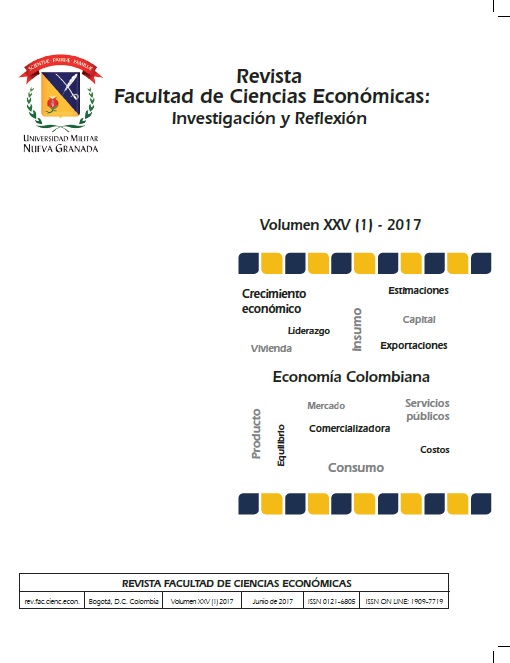Gestión individual del equilibrio entre el trabajo y la vida personal: revisión e integración de la literatura
Resumen
La sociedad y el mercado laboral han sufrido importantes cambios en los últimos años que generaron conflictos entre la vida laboral y personal de los individuos, causando resultados negativos en los mismos (insatisfacción y estrés) y en las organizaciones (aumento de rotación y ausentismo). Actualmente la literatura no brinda conocimiento suficiente para orientar a empleadores y empleados sobre las acciones para evitar el conflicto trabajo-vida. El objetivo de este trabajo es integrar la teoría sobre estrategias individuales para lograr el equilibrio trabajo-vida, identificando sus efectos en los individuos y en la organización que los emplea. Para ello, se revisaron publicaciones en revistas prestigiosas del campo del Management, entre 2000-2015. Se concluye con una discusión sobre las implicancias para gestionar los Recursos Humanos.
Descargas
Lenguajes:
esReferencias bibliográficas
Allen, T. D., Cho, E., y Meier, L. L. (2014). Work–family boundary dynamics. En: Annual Review of Organizational Psychology and Organizational Behavior, 1(1), 99-121.
Allen, T. D., Herst, D. E., Bruck, C. S., y Sutton, M. (2000). Consequences associated with work-to-family conflict: A review and agenda for future research. En: Journal of Occupational Health Psychology, 5(2), 278-308.
Ammons, S. K. (2013). Work-family boundary strategies: Stability and alignment between preferred and enacted boundaries. En: Journal of Vocational Behavior, 82(1), 49-58.
Ashforth, B. E., y, Johnson, S. A. (2001). Which hat to wear? The relative salience of multiple identities in organizational contexts. En M. A. Hogg y D. J. Terry (Eds.), Social identity processes in organizational contexts. 31-48. Nueva York: The Haworth Press.
Ashforth, B. E., Kreiner, G. E., y Fugate, M. (2000). All in a day´s work: Boundaries and micro role transitions. En: Academy of Management Review, 25(3), 472-491.
Ashforth, B. E., y Mael, F. (1989). Social identity theory and the organization. En: Academy of Management Review, 14(1), 20-39.
Baltes, P. B. (1997). On the incomplete architecture of human ontogeny: Selection, optimization, and compensation as foundation of developmental theory. En: American Psychologist, 52(4), 366-380.
Baltes, B. B., y Heydens-Gahir, H. A. (2003). Reduction of work-family conflict through the use of selection, optimization, and compensation behaviors. En: Journal of Applied Psychology, 88(6), 1005-1018.
Baltes, B. B., Zhdanova, L. S., y Clark, M. A. (2011). Examining the relationships between personality, coping strategies, and work–family conflict. En: Journal of Business and Psychology, 26(4), 517-530.
Batt, R., y Valcour, P. M. (2003). Human resources practices as predictors of work-family outcomes and employee turnover. En: Industrial Relations: A Journal of Economy and Society, 42(2), 189-220.
Berkman, L. F., Buxton, O., Ertel K., y Okechukwu, C. (2010). Managers’ practices related to work–family balance predict employee cardiovascular risk and sleep duration in extended care settings. En: Journal of Occupational Health Psychology, 15(3), 316-329.
Bhave, D. P., Kramer, A., y Glomb, T. M. (2010). Work–family conflict in work groups: Social information processing, support, and demographic dissimilarity. En: Journal of Applied Psychology, 95(1), 145-158.
Bruck, C. S., Allen, T. D., y Spector, P. E. (2002). The relation between work–family conflict and job satisfaction: A finer-grained analysis. En: Journal of Vocational Behavior, 60(3), 336-353.
Bulger, C. A., Matthews, R. A., y Hoffman, M. E. (2007). Work and personal life boundary management: Boundary strength, work/personal life balance, and the segmentation-integration continuum. En: Journal of Occupational Health Psychology, 12(4), 365-375.
Butts, M. M., Becker, W. J., y Boswell, W. R. (2015). Hot buttons and time sinks: The effects of electronic communication during nonwork time on emotions and work-nonwork conflict. En: Academy of Management Journal, 58(3), 763-788.
Cappelli, P. (2008). Talent on demand. Managing talent in an age of uncertainty. Boston: Harvard Business School Press.
Carlier, S. I. (2006). Las políticas de conciliación trabajo-familia en las empresas colombianas. En: Estudios Gerenciales, 22(100), 49-70.
Chen, Z., Powell, G. N., y Greenhaus, J. H. (2009). Work-to-family conflict, positive spillover, and boundary management: a person-environment fit approach. En: Journal of Vocational Behavior, 74(1), 82-93.
Chinchilla, M., Poelmans, S., y León, C. (2003). Políticas de conciliación trabajo-familia en 150 empresas españolas (No. D/498). IESE Business School.
Clark, S. C. (2000). Work/family border theory: A new theory of work/family balance. En: Human Relations, 53(6), 747-770.
D’Abate, C. P. (2005). Working hard or hardly working: A study of individuals engaging in personal business on the job. En: Human Relations, 58(8), 1009-1032.
Dabos, G. E., y Rivero, A. G. 2012. Contratos idiosincráticos en la atracción y retención del talento: Tres estudios en organizaciones intensivas en conocimiento de la Argentina. En: Estudios Gerenciales, 28(125), 3-12.
Derks, D., Bakker, A. B., Peters, P., y van Wingerden, P. (2016). Work-related smartphone use, work–family conflict and family role performance: The role of segmentation preference. En: Human Relations, 69(5), 1045-1068.
Derks, D., Duin, D., Tims, M., y Bakker, A. B. (2015). Smartphone use and work–home interference: The moderating role of social norms and employee work engagement. En: Journal of Occupational and Organizational Psychology, 88(1), 155-177.
Derks, D., van Mierlo, H., y Schmitz, E. B. (2014). A diary study on work-related smartphone use, psychological detachment and exhaustion: Examining the role of the perceived segmentation norm. En: Journal of Occupational Health Psychology, 19(1), 74-84.
DiRenzo, M. S., Greenhaus, J. H., y Weer, C. H. (2011). Job level, demands, and resources as antecedents of work–family conflict. En: Journal of Vocational Behavior, 78(2), 305-314.
Eby, L. T., Casper, W. J., Lockwood, A., Bordeaux, C., y Brinley, A. (2005). Work and family research in IO/OB: Content analysis and review of the literature. En: Journal of Vocational Behavior, 66(1), 124-197.
Ferguson, M., Carlson, D., y Kacmar, K. M. (2015). Flexing work boundaries: The spillover and crossover of workplace support. En: Personnel Psychology, 68(3), 581-614.
Frone, M. R., Russell, M., y Cooper, M. L. (1997). Relation of work–family conflict to health outcomes: A four-year longitudinal study of employed parents. En: Journal of Occupational and Organizational Psychology, 70(4), 325–335.
Goff, S. J., Mount, M. K., y Jamison, R. L. (1990). Employer supported child care, work/family conflict, and absenteeism: A field study. En: Personnel Psychology, 43(4), 793-809.
Golden, A. G., y Geisler, C. (2007). Work–life boundary management and the personal digital assistant. En: Human Relations, 60(3), 519-551.
Golik, M. (2013). Las expectativas de equilibrio entre vida laboral y vida privada y las elecciones laborales de la nueva generación. En: Cuadernos de Administración, 26(46), 107-133.
Graen, G. B., y Uhl-Bien, M. (1995). Relationship-based approach to leadership: Development of leader-member exchange (LMX) theory of leadership over 25 years: Applying a multi-level multi-domain perspective. En: The Leadership Quarterly, 6(2), 219-247.
Greenhaus, J. H., Parasuraman, S., y Collins, K. M. (2001). Career involvement and family involvement as moderators of relationships between work–family conflict and withdrawal from a profession. En: Journal of Occupational Health Psychology, 6(2), 91–100.
Greenhaus, J. H., y Powell, G. N. (2003). When work and family collide: Deciding between competing role demands. Organizational Behavior and Human Decision Processes, 90(2), 291-303.
Hahn, V. C., y Dormann, C. (2013). The role of partners and children for employees' psychological detachment from work and well-being. En: Journal of Applied Psychology, 98(1), 26-36.
Halbesleben, J. R., Harvey, J., y Bolino, M. C. (2009). Too engaged? A conservation of resources view of the relationship between work engagement and work interference with family. En: Journal of Applied Psychology, 94(6), 1452-1465.
Halbesleben, J. R., Zellars, K. L., Carlson, D. S., Perrewé, P. L., y Rotondo, D. (2010). The moderating effect of work-linked couple relationships and work–family integration on the spouse instrumental support-emotional exhaustion relationship. En: Journal of Occupational Health Psychology, 15(4), 371-387.
Hall, D. T., y Richter, J. (1988). Balancing work life and home life: What can organizations do to help?. En: Academy of Management Executive, 2(3), 213-223.
Hecht, T. D., y Allen, N. J. (2009). A longitudinal examination of the work–nonwork boundary strength construct. En: Journal of Organizational Behavior, 30(7), 839-862.
Heller, L. (2013). Mujeres en la cumbre corporativa: el caso de la Argentina. En: Revista del Centro de Estudios de Sociología del Trabajo (CESOT), 1(3), 68-96.
Hornung, S., Rousseau, D. M., Weigl, M., Müller, A., y Glaser, J. (2014). Redesigning work through idiosyncratic deals. En: European Journal of Work and Organizational Psychology, 23(4), 608-626.
Ilgen, D.R., Major, D.A., Hollenbeck, J.R., y Sego, D.J. (1995). Raising an individual decision making model to the team level: A new research model and paradigm. En R. A. Guzzo, E. Salas y Associates (Eds), Team effectiveness and decision making in organizations. 113-48. San Francisco, CA: Jossey-Bass.
Ilies, R., Wilson, K. S., y Wagner, D. T. (2009). The spillover of daily job satisfaction onto employees' family lives: The facilitating role of work-family integration. En: Academy of Management Journal, 52(1), 87-102.
Jalilvand, M. (2000). Married women, work, and values. En: Monthly Labor Review, 123: 26-31.
Kahn, R. L.. Wolfe, D. M., Quinn, R., Snoek, J. D., y Rosenthal, R. A. (1964). Organizational stress: Studies in role conflict and ambiguity. Oxford, England: Wiley.
Koch, A. R., y Binnewies, C. (2015). Setting a good example: Supervisors as work-life-friendly role models within the context of boundary management. En: Journal of Occupational Health Psychology, 20(1), 82-92.
Kossek, E. E., y Lambert, S. J. (2005). "Work-Family Scholarship": Voice and Context. Lawrence Erlbaum Associates Publishers.
Kossek, E. E., Lautsch, B. A., y Eaton, S. C. (2006). Telecommuting, control, and boundary management: Correlates of policy use and practice, job control, and work–family effectiveness. En: Journal of Vocational Behavior, 68(2), 347-367.
Kossek, E. E., Ruderman, M. N., Braddy, P. W., y Hannum, K. M. (2012). Work–nonwork boundary management profiles: A person-centered approach. En: Journal of Vocational Behavior, 81(1), 112-128.
Kreiner, G. E. (2006). Consequences of work‐home segmentation or integration: A person‐environment fit perspective. En: Journal of Organizational Behavior, 27(4), 485-507.
Kreiner, G. E., Hollensbe, E. C., y Sheep, M. L. (2006). Where is the “me” among the “we”? Identity work and the search for optimal balance. En: Academy of Management Journal, 49(5), 1031-1057.
Kreiner, G. E., Hollensbe, E. C., y Sheep, M. L. (2009). Balancing borders and bridges: Negotiating the work-home interface via boundary work tactics. En: Academy of Management Journal, 52(4), 704-730.
Lanaj, K., Johnson, R. E., y Barnes, C. M. (2014). Beginning the workday yet already depleted? Consequences of late-night smartphone use and sleep. Organizational Behavior and Human Decision Processes, 124(1), 11-23.
Lapierre, L. M., Steenbergen, E. F., Peeters, M. C., y Kluwer, E. S. (2015). Juggling work and family responsibilities when involuntarily working more from home: A multiwave study of financial sales professionals. En: Journal of Organizational Behavior, 37(6), 804-822.
Liu, J., Kwan, H. K., Lee, C., y Hui, C. (2013). Work‐to‐family spillover effects of workplace ostracism: The role of work‐home segmentation preferences. En: Human Resource Management, 52(1), 75-93.
Major, D. A., y Germano, L. M. (2006). The changing nature of work and its impact on the work-home interface. En: F. Jones, R. Burke, y M. Westman (Eds.), Work-life balance: A psychological perspective. 13–38. London: Psychology Press.
Matthews, R. A., y Barnes-Farrell, J. L. (2010). Development and initial evaluation of an enhanced measure of boundary flexibility for the work and family domains. En: Journal of Occupational Health Psychology, 15(3), 330-346.
Matthews, R. A., Barnes-Farrell, J. L., y Bulger, C. A. (2010). Advancing measurement of work and family domain boundary characteristics. En: Journal of Vocational Behavior, 77(3), 447-460.
Matthews, R. A., Winkel, D. E., y Wayne, J. H. (2014). A longitudinal examination of role overload and work–family conflict: The mediating role of interdomain transitions. En: Journal of Organizational Behavior, 35(1), 72-91.
Mauno, S., Kinnunen, U., y Pyykkö, M. (2005). Does work–family conflict mediate the relationship between work–family culture and self‐reported distress? Evidence from five Finnish organizations. En: Journal of Occupational and Organizational Psychology, 78(4), 509-530.
McDowall, A., y Lindsay, A. (2014). Work–life balance in the police: The development of a self-management competency framework. En: Journal of Business and Psychology, 29(3), 397-411.
McNall, L. A., Scott, L. D., y Nicklin, J. M. (2015). Do positive affectivity and boundary preferences matter for work–family enrichment? A study of human service workers. En: Journal of Occupational Health Psychology, 20(1), 93-104.
Methot, J. R., y LePine, J. A. (2016). Too close for comfort? Investigating the nature and functioning of work and non-work role segmentation preferences. En: Journal of Business and Psychology, 31(1), 103-123.
Mitchelson, J. K. (2009). Seeking the perfect balance: Perfectionism and work–family conflict. En: Journal of Occupational and Organizational Psychology, 82(2), 349-367.
Michel, A., Bosch, C., y Rexroth, M. (2014). Mindfulness as a cognitive–emotional segmentation strategy: An intervention promoting work–life balance. En: Journal of Occupational and Organizational Psychology, 87(4), 733-754.
Mickel, A. E., y Dallimore, E. J. (2009). Life-quality decisions: Tension-management strategies used by individuals when making tradeoffs. En: Human Relations, 62(5), 627-668.
Montenegro, G. O. (2007). La relación existente entre el conflicto trabajo-familia y el estrés individual en dos organizaciones colombianas. En: Cuadernos de Administración, 20(34), 139-160.
Mustafa, M., y Gold, M. (2013). ‘Chained to my work'? Strategies to manage temporal and physical boundaries among self‐employed teleworkers. En: Human Resource Management Journal, 23(4), 413-429.
Ng, T. W., y Feldman, D. C. (2010). Idiosyncratic deals and organizational commitment. En: Journal of Vocational Behavior, 76(3), 419-427.
Nippert-Eng, C. E. (1996). Home and work: Negotiating boundaries through everyday life. Chicago: University of Chicago Press.
Olson-Buchanan, J. B., y Boswell, W. R. (2006). Blurring boundaries: Correlates of integration and segmentation between work and nonwork. En: Journal of Vocational Behavior, 68(3), 432-445.
Parasurman, S., y Simmers, C. A. (2001). Type of employment, work–family conflict and well-being: A comparative study. En: Journal of Organizational Behavior, 22(5), 551–568.
Park, Y., Fritz, C., y Jex, S. M. (2011). Relationships between work-home segmentation and psychological detachment from work: the role of communication technology use at home. En: Journal of Occupational Health Psychology, 16(4), 457-467.
Perlow, L. A. (1998). Boundary control: The social ordering of work and family time in high tech corporations. En: Administrative Science Quarterly, 43: 328-357.
Pleck, J. H. (1977). The work-family role system. En: Social Problems, 24: 417-427.
Poelmans, S., y Beham, B. (2008). The moment of truth: Conceptualizing managerial work-life policy allowance decisions. En: Journal of Occupational and Organizational Psychology, 81(3), 393-410.
Post, C., DiTomaso, N., Farris, G. F., y Cordero, R. (2009). Work–family conflict and turnover intentions among scientists and engineers working in R&D. En: Journal of Business and Psychology, 24(1), 19-32.
Powell, G. N., y Greenhaus, J. H. (2006). Managing incidents of work-family conflict: A decision-making perspective. Human Relations, 59(9), 1179-1212.
Radcliffe, L. S., y Cassell, C. (2014). Resolving couples’ work–family conflicts: The complexity of decision making and the introduction of a new framework. En: Human Relations, 67(7), 793-819.
Rau, B. L., y Hyland, M. A. M. (2002). Role conflict and flexible work arrangements: The effects on applicant attraction. En: Personnel Psychology, 55(1), 111-136.
Richie, M. F. (2006). Demographic implications for work–family research. En M. Pitt-Catsouphes, E. E. Kossek, y S. Sweet (Eds.), The work and family handbook: Multidisciplinary perspectives, methods, and approaches. 125–140. Mahwah, NJ: Lawrence Erlbaum.
Root, L. S., y Wooten, L. P. (2008). Time out for family: Shift work, fathers, and sports. En: Human Resource Management, 47(3), 481-499.
Rosen, C. C., Slater, D. J., y Johnson, R. E. (2013). Let’s make a deal development and validation of the ex post i-deals scale. En: Journal of Management, 39(3), 709-742.
Rothbard, N. P., Phillips, K. W., y Dumas, T. L. (2005). Managing multiple roles: Work-family policies and individuals’ desires for segmentation. En: Organization Science, 16(3), 243-258.
Rousseau, D. M., Ho, V. T., y Greenberg, J. (2006). I-deals: Idiosyncratic terms in employment relationships. En: Academy of Management Review, 31(4), 977–994.
Rousseau, D. M., Hornung, S., y Kim, T. G. (2009). Idiosyncratic deals: Testing propositions on timing, content, and the employment relationship. En: Journal of Vocational Behavior, 74(3), 338-348.
Sánchez-Vidal, M. E., Cegarra-Leiva, D., y Cegarra-Navarro, J. G. (2011). ¿Influye el conflicto trabajo-vida personal de los empleados en la empresa. En: Universia Business Review, 29: 100-115.
Scholarios, D., y Marks, A. (2004). Work‐life balance and the software worker. En: Human Resource Management Journal, 14(2), 54-74.
Shockley, K. M., y Allen, T. D. (2007). When flexibility helps: Another look at the availability of flexible work arrangements and work–family conflict. En: Journal of Vocational Behavior, 71(3), 479-493.
Shockley, K. M., y Allen, T. D. (2010). Investigating the missing link in flexible work arrangement utilization: An individual difference perspective. En: Journal of Vocational Behavior, 76(1), 131-142.
Shockley, K. M., y Allen, T. D. (2015). Deciding between work and family: An episodic approach. En: Personnel Psychology, 68(2), 283-318.
Snow, D. A., y Anderson, L. (1987). Identity work among the homeless: The verbal construction and avowal of personal identities. En: American Journal of Sociology, 92: 1336-1371.
Sonnentag, S., Kuttler, I., y Fritz, C. (2010). Job stressors, emotional exhaustion, and need for recovery: A multi-source study on the benefits of psychological detachment. En: Journal of Vocational Behavior, 76(3), 355-365.
Sturges, J. (2008). All in a day's work? Career self‐management and the management of the boundary between work and non‐work. En: Human Resource Management Journal, 18(2), 118-134.
Sturges, J. (2012). Crafting a balance between work and home. En: Human Relations, 65(12), 1539-1559.
Trapero, F. G. A., Sánchez, L. M. V., y De la Garza García, J. (2013). Políticas de diversidad y flexibilidad laboral en el marco de la responsabilidad social empresarial. Un análisis desde la perspectiva de género. En: Estudios Gerenciales, 29(127), 161-166.
Trefalt, S. (2013). Between you and me: Setting work-nonwork boundaries in the context of workplace relationships. Academy of Management Journal, 56(6), 1802-1829.
Voydanoff, P. (2007). Work, family, and community: Exploring interconnections. Mahwah, Nueva Jersey: Lawrence Erlbaum.
Wayne, J. H., Randel, A. E., y Stevens, J. (2006). The role of identity and work–family support in work–family enrichment and its work-related consequences. Journal of Vocational Behavior, 69(3), 445-461.
Williams, K. D. (2001). Ostracism: The power of silence. New York: Guilford Press.
Winkel, D. E., y Clayton, R. W. (2010). Transitioning between work and family roles as a function of boundary flexibility and role salience. En: Journal of Vocational Behavior, 76(2), 336-343.
Wrzesniewski, A., y Dutton, J. E. (2001). Crafting a job: Revisioning employees as active crafters of their work. En: Academy of Management Review, 26(2), 179-201.
Young, L. M., Baltes, B. B., y Pratt, A. K. (2007). Using selection, optimization, and compensation to reduce job/family stressors: Effective when it matters. En: Journal of Business and Psychology, 21(4), 511-539.












